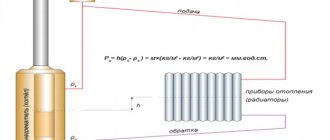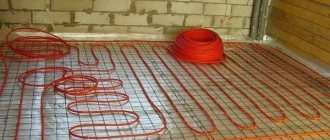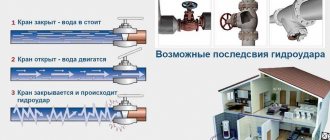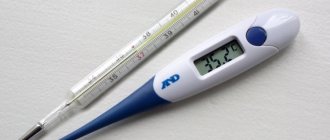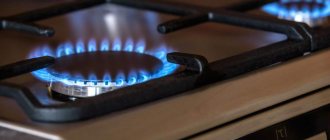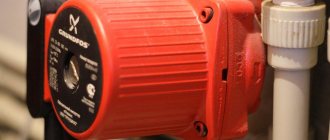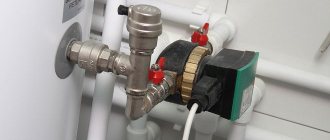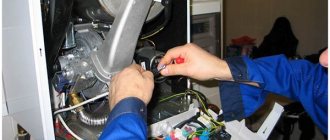Hot water supply systems can be connected directly (in open heating systems) or independently through water heaters (in closed heating systems). The type of heat supply system (open or closed) is determined during the design, and the choice of one or another system is determined by technical and economic indicators.
Direct connection to the supply and return pipelines (a). Hot water of the required temperature is prepared by mixing it using a thermostat from the supply and return pipelines. In the thermostat, the pressure of the water coming from the supply pipeline is throttled to the pressure of the return pipeline (and its amount depends on the temperature of the water in the return pipeline). In accordance with SNiP 41-02-2003 “Heating networks”, the temperature of the heated water at the outlet of the water heater into the hot water supply system should be taken equal to 60 °C. Therefore, when the temperature in the return pipeline is above 60 °C, the water comes entirely from the return pipeline, and when the water temperature in it is below 60 °C, from the return and supply pipelines; at a water temperature in the supply pipeline equal to 60 ° C - completely from it.
When connecting the heating system (6) independently, leaks are replenished from the hot water supply system after the displacement unit. If the pressure in the return pipeline of the heating network is insufficient to supply water to the hot water supply system, install a pressure regulator (pressure) with sufficient total pressure or a booster pump, which can also be a circulation pump. Circulation can be carried out using throttle washers installed on the return pipeline of the heating system (winter mode) and on the circulation pipeline (summer mode). If there is a pressure regulator (pressure), the throttle washer for winter mode is not installed.
Switching on a hot water heater in a parallel circuit
1 - mud trap; 2 - water heater; 3 — heated water temperature regulator; 4 - circulation pump; 5 - distribution pipeline; 6 - water riser; 7 - circulation riser; 8 - circulation pipeline; 9 - heating system; 10 — constant flow regulator; 11 — elevator
In the absence of storage tanks, due to uneven consumption of hot water, significant fluctuations in the flow of network water are observed, which affects the parallel connected heating system. Therefore, to stabilize the water flow in the heating system, a constant flow regulator is installed in front of it.
Independent connection with inclusion of a hot water supply water heater according to a mixed scheme. The heating fluid (mains water) branches into two parallel flows: one enters the second stage water heater, the other goes into the heating system. From the heating system, network water flows into the first stage water heater. The heated tap water first enters stage I, where it is heated by coolant supplied from the heating system and from the water heater of stage II, and then into stage II until it is heated to the required temperature.
More information about the “low return” scheme
Application of standard DHW schemes
Today, existing regulatory documents regulate the choice of DHW construction scheme when designing heating points.
According to SP 41-101-95 “Design of Heat Points”, depending on the ratio of the maximum heat flow for hot water supply Qhmax and the maximum heat flow for heating Qomax, the following DHW schemes can be used: - single-stage scheme - two-stage scheme * Parallel single-stage scheme can also be used in in the case of heat supply from small boiler houses (<35 MW), regardless of the ratio of heat loads (subject to a feasibility study).
Parallel single-stage circuit
The advantages of this scheme: simplicity and relative cheapness. Disadvantages - the scheme is uneconomical in terms of coolant consumption, its use leads to an increase in the power of pumping stations and the diameters of heating network pipes.
Among two-stage schemes, the most widespread in Russia is the two-stage mixed DHW connection scheme.
Two-stage mixed scheme
is quite simple and allows saving up to 40% of coolant consumption compared to a parallel single-stage circuit. But it also has a number of disadvantages:
- strong mutual influence of hot water supply and heating;
- relatively rapid contamination of the first stage;
- the need for careful selection of the heat exchanger;
- high level of capital investment for the purchase of two heat exchangers.
Two-stage sequential circuit
is used much less frequently, since, despite significant savings in coolant (savings of up to 60% relative to a parallel single-stage circuit), it has a number of significant disadvantages:
- complexity of calculation;
- the need to link the operation of hot water supply and heating;
- periodic overheating of water in the heating system, which increases its wear;
- temperature fluctuations in the building;
- high level of capital investment for automation equipment and the purchase of two heat exchangers;
- frequent complaints about process automation.
According to SP 41-101-95 clause 3.20, other schemes for connecting heat consumers to heating networks can also be used, ensuring minimal water consumption in heating networks, heat savings, during a feasibility study.
Ridan solution
offers an alternative DHW scheme - a scheme with “lower return” of DHW. The use of the scheme is possible provided that a plate heat exchanger is used (there is no economic effect for a shell-and-tube heat exchanger). The proposed scheme is identical to the parallel single-stage scheme, but differs in the design of the heat exchanger for temperatures not 70/30 (for the 150/70 schedule), but for a lower hot water return temperature (~ 20 ° C)
Technological diagram of hot water supply with “low return”
Advantages compared to a single-stage scheme:
- coolant savings at equal heat loads – up to 40%;
- releasing the heat transport reserve of the heating network to provide peak loads or connect new consumers;
- the scheme is more efficient in ensuring the required hot water supply temperature, which is especially important when the temperature parameters of the heating network coolant are not high enough or when the pressure difference between the forward and return routes of the heating network is insufficient.
Advantages compared to two-stage schemes:
- reduction in the cost of purchasing a heat exchanger (one heat exchanger is purchased instead of two);
- reduction in the cost of piping (up to 50%) and installation;
- ability to work at low pressure drops;
- no influence on the hydraulics of the heating system;
- simplification and reduction of costs (up to 25%) for equipment maintenance through the use of one heat exchanger;
- simplification of the heat supply system, small dimensions of the thermal circuit unit;
- low hydraulic resistance.
Top best models
Let's consider several pump models with different design features:
With dry rotor
Among the most popular household pumps with a dry rotor, the following models stand out:
Jemix W15GR15-A .
The pump has a durable cast iron body and an impeller made of plastic, neutral to moisture. The engine has an aluminum casing that is not prone to corrosion. The model's productivity is 1.5 m3/hour.- Comfort X15GR 15 . Domestic model, the productivity of which is 1.8 m3/hour. The pump is capable of working with both cold and hot water at temperatures up to 100 degrees.
- Wilo PH-101 E. A German pump with a capacity of 9 m3/hour with a rated power of 100 W. Designed to work with relatively low temperatures - up to 40°. Effective when installed in a heated floor system.
The above models are popular and in high demand, although other types of pumps also show a quite successful set of performance qualities.
With wet rotor
The top three models include:
- Grundfos UPS 25-40 180 (45 W) . The products of the Danish company are in high demand due to their successful set of characteristics. With a power of only 25 W, it provides a productivity of 2.93 m3/hour. The maximum liquid temperature is 110°, which allows the model to be installed in radiator heating systems.
- Wilo PB-201EA . 200-watt pump equipped with dry-running protection. Capable of moving up to 3.3 m3/hour. The maximum water temperature is 60°, which is suitable for hot water systems.
- VALTEC VRS 25/8-180 . The pump is produced by a Russian-Italian company. With a power of 182 W, it provides a productivity of 7 m3/hour. The maximum temperature is 110°, which is suitable for the heating circuit.
Most models from these well-known companies have similar characteristics.
3 bath models
To supply hot water in a bathhouse, you need a pump with a minimum initial pressure, otherwise you will either have to install the tank at a height of more than 2 m, or lower the pump itself below floor level. The most popular models are:
Grundfos UPA 15-90 N.
Compact model capable of pumping up to 1.5 m3/hour of hot (up to 95°) water. Capable of creating pressure up to 1 bar, which is comparable to centralized water supply networks.- Aquario ARM-50 . Monoblock with one impeller. Temperature - up to 90°, provides supply up to 60 l/min.
- 12V DC5H . Diaphragm pump, which is powered by a 12 volt source. For a bathhouse, this is a good option that ensures safety for people.
Calculation
Selecting a suitable heat exchanger is difficult to do based on its power or throughput alone. The efficiency of hot water preparation depends on the condition of the coolant in the primary circuit and in the second, on the material and design of the heat exchanger, the speed and mass fraction of the coolant passing per unit time through the plate heat exchanger. However, of course, you should first perform a calculation to arrive at a certain combination of power and performance in order to select the appropriate model.
Basic data required for calculation:
- Type of medium in both circuits (water-water, oil-water, steam-water)
- Temperature of the coolant in the heating system;
- The maximum permissible decrease in coolant temperature after passing through the heat exchanger;
- Initial temperature of water used for hot water supply;
- Required DHW temperature;
- Target hot water consumption in maximum consumption mode.
In addition, the calculation formulas include the specific heat capacity of the liquid in both circuits. For hot water supply, the table value for the initial water temperature is used, usually +20°C, equal to 4.182 kJ/kg*K. The specific heat capacity should be separately determined for the coolant if it contains antifreeze or other additives to improve its qualities. Similarly, for centralized heating, an approximate value or an actual value is taken based on data from the heat and communal services company.
The target flow rate is determined by the number of users for hot water and the number of devices (faucets, dishwasher, washing machine, shower) where it will be used. According to the requirements of SNiP 2.04.01-85, the following hot water flow rates are required:
- for the sink – 40 l/h;
- bathroom – 200 l/h;
- shower – 165 l/h.
The value for the sink is multiplied by the number of devices in the house that can be used in parallel, and added to the value for the bathtub or shower, depending on what is being used. For a dishwasher and washing machine, the values are taken from the passport and instructions and only if they support the use of hot water.
The second basic value is the power of the heat exchanger. It is calculated based on the obtained value of liquid flow and the difference in water temperatures at the inlet to the heat exchanger and at the outlet.
where m is water flow, C is specific heat capacity, Δt is the difference in water temperatures at the inlet and outlet of the PHE.
To obtain the mass flow rate of water, the flow rate expressed in l/h should be multiplied by the density of water 1000 kg/m3.
The efficiency of heat exchangers is estimated at 80-85%, and much depends on the design of the equipment itself, so the resulting value should be divided by 0.8(5).
On the other hand, the power limitation will be the calculation performed on the side of the primary circuit with the coolant, where, using the difference in permissible temperatures for the heating system, we obtain the maximum permissible power intake. The end result will be a compromise between the two values obtained.
If the power intake to heat the required amount of hot water is not enough, then it is more reasonable to use two heating stages and, accordingly, two heat exchangers. The power is distributed between them equally according to the required calculation. One stage performs preheating using the reduced temperature heating return as a heat source. The second PHE already finally heats the water using hot water from the heating supply.
Design and principle of operation
A plate heat exchanger (PHE) ensures the transfer of heat from a heated coolant to a cold one, without mixing them, decoupling the two circuits from each other. The coolant can be steam, water or oil. In the case of hot water supply, the heat source is often the heating fluid of the heating system, and the heated medium is cold water.
Structurally, the heat exchanger is a group of corrugated plates assembled parallel to each other. Between them, channels are formed through which the coolant and the heated medium flow, and they alternate layer by layer without mixing. By alternating the layers through which fluids of both circuits flow, the heat exchange area increases.
Heat exchanger operating diagram
The corrugation of the bowl is performed in the form of waves, moreover, oriented so that the channels of one circuit are located at an angle to the channels of the second circuit.
The connections of the inputs and outputs are made so that the liquids flow towards each other.
The surface and material of the plates are selected based on the required heat transfer power and the type of coolant. In particularly efficient and sophisticated heat exchangers, the surface is shaped to generate vortices near the surface of the plate, increasing heat transfer without creating much resistance to the overall current.
The heat exchanger is connected between two circuits:
- In series with the heating system or in parallel with the presence of control valves.
- To the inlet from the cold water supply and the outlet to the DHW consumer.
Cold water flowing through the heat exchanger is heated by heat from the heating system to the required temperature and supplied to the consumer tap.
Main characteristics of plate heat exchanger:
- Power, W;
- Maximum coolant temperature, oC;
- Throughput, productivity, liters/hour;
- Hydraulic resistance coefficient.
The power depends on the total heat exchange area, the temperature difference in both circuits between the input and output, and even on the number of plates.
The maximum temperature is set by the selection of materials and the method of connecting the plates and the heat exchanger body.
The throughput increases with the number of plates, since they are connected virtually in parallel, each new pair of plates adds an additional channel for fluid flow.
The coefficient of hydraulic resistance is important when calculating the load on the heating system, where the choice of a circulation pump depends on it, and is also important for other heat sources. Depends on the type of corrugation of the plates and the cross-sectional size of the channels and their number.
It is based on these parameters that a heat exchanger is ultimately selected for a specific situation. Most often, plate heat exchangers have a collapsible design, in which you can increase or decrease the number of plates and choose their type and size. The power and performance of the heat exchanger must be sufficient to heat running cold water without creating a critical load on the heating system.
For the most popular cases, such as providing hot water to a private household, house or apartment, ready-made heat exchangers with constant characteristics are produced.
The most common types of breakdowns and how to fix them
The most common type of breakdown is the impeller stopping. The device hums but does not work properly. To solve the problem, you need to turn off the circulation, drain the water, disassemble the device and move the impeller. Typically, the cause is the adhesion of small particles or the entry of foreign objects into the flow.
The second most common type of malfunction is overheating . It occurs due to lack of lubrication on the bearings or due to the regular entry of air into the system. The problem can be solved if the rotating parts are well lubricated and all connections are reliably sealed.
Everything you need to know about hot water is presented in this section of the site.
Connecting equipment
Installing such equipment is not too difficult . It needs to be embedded at some point in the pipeline and connected to the electrical network.
The unit can be installed on a return or direct supply pipe . For example, if the apartment is equipped with a heated floor system, it is advisable to connect the pump to the return pipes. This will stimulate the movement of water.
When it comes to a continuous hot water pipeline , it is advisable to install it on a direct supply pipe. Then the people living in the house will receive hot water in the quantity they need.
Installation of a circulation pump in a water supply system is carried out in several stages:
- Assembling the pump in accordance with the instructions included with the device.
- Choosing an installation location.
- Shutdown of water supply.
- Cutting or removing part of a pipe.
- Connecting the unit using flanged or threaded connections.
- Sealing all joints.
- Connecting the device to the electrical network.
- Testing and setting up the device.
